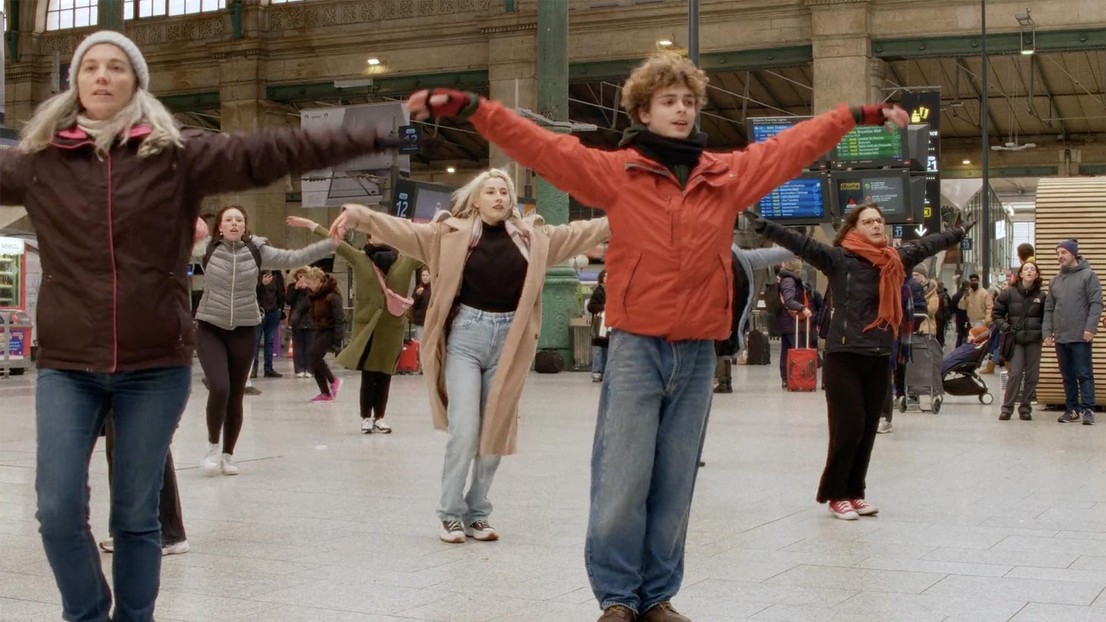A film that explores dance as the language of science

© Jacques Lévy, Gare du Monde, 2025
The film Gare du Monde (World Station) brings viewers into Paris’s Gare du Nord to show how cinema, music, and dance can be catalysts for scientific invention. It will be shown on October 7 as part of EPFL College of Humanities’ (CDH) biannual Les Culturelles festival.
The film was directed by Jacques Lévy, an honorary professor of geography and urbanism at EPFL who now is part of the Chôros research network. Through lens of the Gare du Nord station, Europe’s largest railway hub, Gare du Monde uses dance to investigate if the station can be tamed by the travelers, workers, and passersby who set it in motion.
Where did the idea for this film come from?
The idea for Gare du Monde came shortly after I made a film at EPFL in 2012-2013 called Urbanity/ies. The film used voiceovers, which bothered me a little. It was, of course, in keeping with the logic of the film, but I think a good documentary film should avoid these voiceovers because they make it seem as if there is an omniscient character, and I don’t think it’s in the spirit of research to make the audience think that we already know everything. So I decided to make a film without any voiceovers, which means that the viewer won't need an oral commentary to understand what the film is about.
I needed to experiment with a new language that is not usually used in scientific work, and I chose the language of contemporary dance. In research, we traditionally use written language, spoken language, or mathematical equations, and to a lesser extent, photography and film. But music and dance are used very little. I said to myself, “I'm going to tell a story about researchers exploring a space, and these researchers will be played by dancers.”
Why did you choose to use the Gare du Nord as the film’s location?
After I had considered filming in the Pearl Delta in China, probably the major agglomeration worldwide, I decided to explore a more familiar place Paris’ Gare du Nord, a particularly dense microcosm which sums up, on its own way, the entire diversity of the contemporary World.
The Gare du Nord is a place of great social diversity because there are these very chic people who take the Eurostar to London, and right next to them are the people who take the RER to the northern suburbs of Paris, which are the poorest. By then I had left EPFL and was living in Paris again, so the station was right at my fingertips.
In the final scene, the crowd in the station joins your researchers in dance. Was that real? Or were those also hired dancers?
Research doesn't stop at the production of concepts and theories but instead continues through dissemination in society. This is also part of the researcher's job. So we decided that we would introduce a final sequence where the researchers have finished their work and are trying to explain their discoveries to the audience in the station.
The story behind this scene is that the researchers are trying to convey their ideas, but no one understands them and no one is dancing. Luckily, in the lobby of the Gare du Nord, there are people who turn out to be mediators, that is, people who can understand both the language of the researchers, which in this case is dance, and the language of the general public. In the social sciences, these mediators could be journalists, teachers, everything related to popular culture, community colleges—there are many structures that serve as interfaces between research and the public.
We hired about 25 amateur dancers, who were intermediaries, using the movements of their bodies to link the dancers/researchers to the ordinary citizens. We weren't sure it would work. It was Sunday afternoon, and I think it was the coldest day of the year. We couldn't afford to make any mistakes because we had all this equipment and people and a strict schedule. So if it didn't work that day, it might have been postponed for a year. But it went well. We had a significant number of people from the crowd participating in the dancing. There was even one who was so good that afterwards, he joined the team of professional dancers!
You’ll be showing this film at EPFL as part of Les Culturelles – why do you think it's important to show a film like this at a school like EPFL?
EPFL is where I started out as a director, so I'm really touched that EPFL is interested in this film. When I was at EPFL, I taught a course on cities and had the students make films. I was very impressed by the fact that, even though they had never taken a film course, they were very good at it and learned editing very quickly.
I think that at EPFL, particularly in the world of architecture at ENAC, there is a strong audiovisual culture, which has also spread among young people in general. Expertise in moving images has progressed enormously. Everyone makes videos and posts them on social media. So this is also an invitation to teachers, researchers, and students alike to embrace cinematic language as a way of expressing their scientific ideas. It's within their reach.